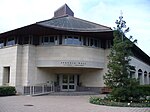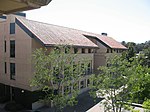Kavli Institute for Particle Astrophysics and Cosmology
2003 establishments in CaliforniaKavli InstitutesLaboratories in the United StatesStanford University independent research
The Kavli Institute for Particle Astrophysics and Cosmology (KIPAC) is an independent joint laboratory of Stanford University and the SLAC National Accelerator Laboratory, founded in 2003 by a gift by Fred Kavli and The Kavli Foundation. It is housed on the grounds of the SLAC National Accelerator Laboratory, as well as on the main Stanford campus. Roger Blandford was the director from 2003 until 2013, and Steven Kahn was the initial deputy director. Tom Abel was appointed acting director in 2013, and director in 2015. In 2018, Risa Wechsler took the position of KIPAC's director. Bruce Macintosh is the deputy director.
Excerpt from the Wikipedia article Kavli Institute for Particle Astrophysics and Cosmology (License: CC BY-SA 3.0, Authors).Kavli Institute for Particle Astrophysics and Cosmology
Panama Mall,
Geographical coordinates (GPS) Address Nearby Places Show on map
Geographical coordinates (GPS)
| Latitude | Longitude |
|---|---|
| N 37.42818 ° | E -122.1726 ° |
Address
Stanford University
Panama Mall 408
94305
California, United States
Open on Google Maps








